Make the Only Tomato Cages You’ll Ever Need, in Minutes!
Updated in January, 2016, just for you:
You may be tempted to do it, but don’t even think about it.
Don’t buy those flimsy wire cages marketed in big box stores or farm stores as “tomato cages.” Well, not unless you’re planning to use them as supports for something polite and well-behaved, such a pepper plant or maybe a leggy perennial. Don’t try to use them for your tomato plants.
Learn from my mistake!
In my first garden year–lo, many, many years ago–I bought a few of these cages and blithely placed them over my little tomato plants. I stood back. I admired. Couldn’t wait.
My hopes: very high! I knew that proper tomato support and garden tidiness was finally mine!
Within weeks, the tomato plants had grown to the top of the cages. So far, so good. But quickly the vines grew out the tops and sides of the cages and were spilling to the ground. By the middle of the summer, the cages were totally lost and invisible within the monstrous tomato vines, which now were all over the place, the tomatoes lying willy-nilly on the ground, my tomato patch a cluttered, tumbled mess.
My hopes, dashed.
My tomatoes, lost and damaged amidst the wreckage. It was a heart-rending sight for somebody who takes her gardening fairly seriously, that is to say, moi.
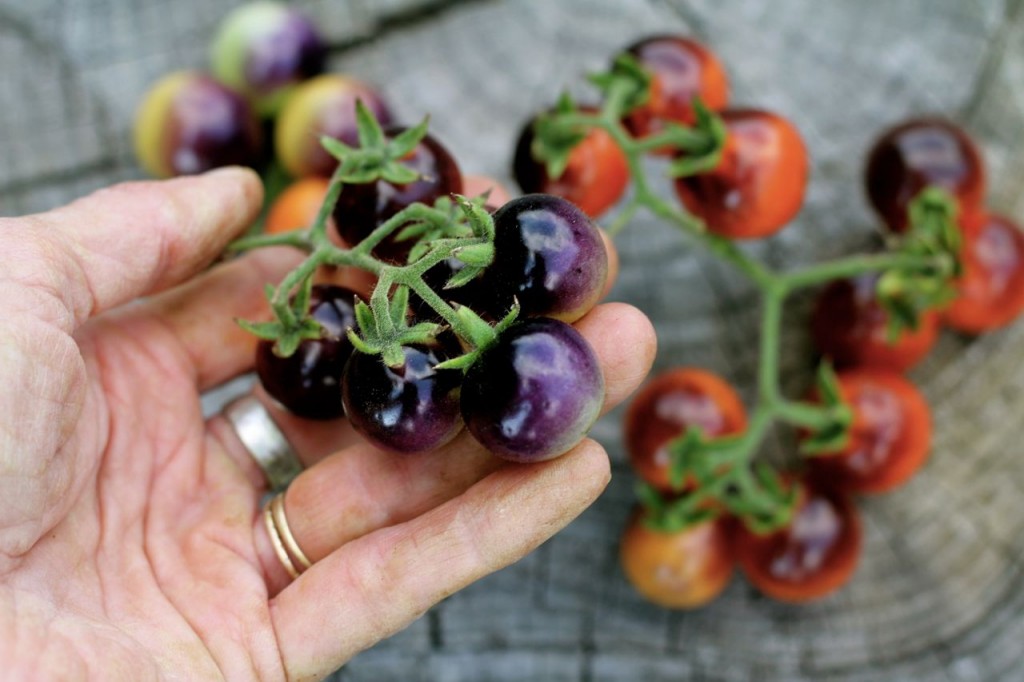
“Blue Berry” tomato, from Baker Creek Heirloom Seeds: You don’t want these gorgeous babies down in the dirt, do you?
Those delicate cages are wholly inadequate for supporting tomato plants–at least here in Nebraska. I won’t say much more, since–who knows–probably somewhere in the world they are perfectly adequate for holding up tomato vines, and--who knows?–perhaps the designer of these cages is a sweet octogenarian who might be–at this very moment!–squinting at these words. 🙁
I would hate to hurt this lovely person’s feelings. Especially for this older tomato cage designing person: I AM SURE YOU ARE VERY SWEET AND WELL-INTENTIONED!
However: my heirloom tomato vines are monsters, making lush and verdant jungles out of my tomato patch. Take a look. Below. Right now. See?
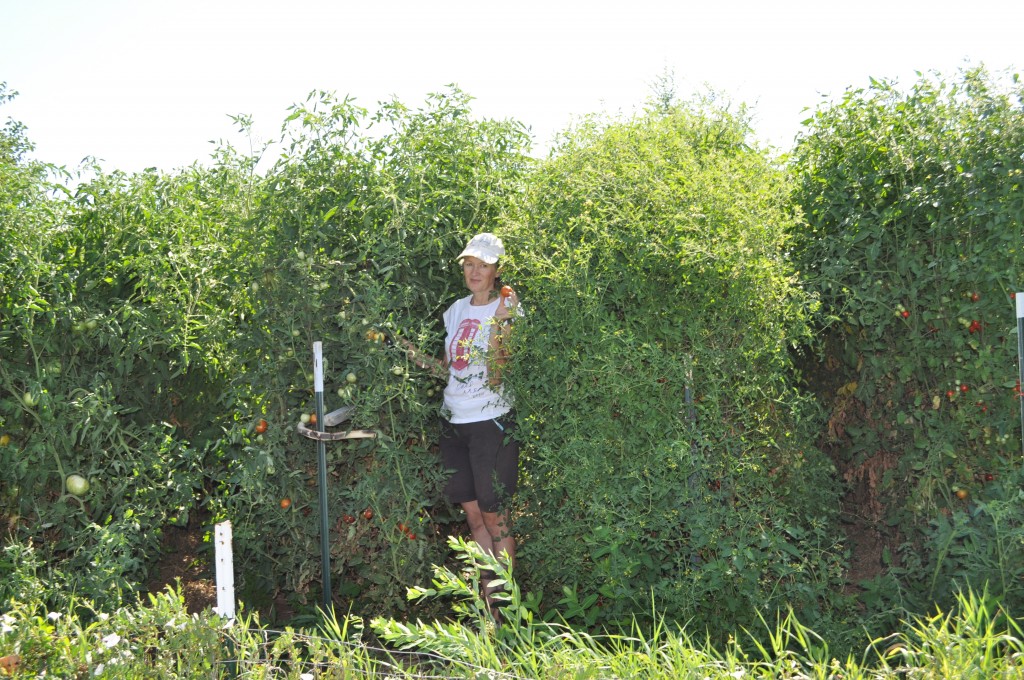
This is me, myself, in my jungle of tomato plants last summer. (Yes, I planted the rows too close together. Again.) You can see why using the small cages will never do.
I learned my lesson after that first summer, and I searched for a better option for tomato vine support. Of course I turned to my Dad, first–the proverbial font of any knowledge that is worth knowing, and an avid gardener, himself–and he helped me make my first batch of real tomato cages. I probably started out with ten, that first summer.
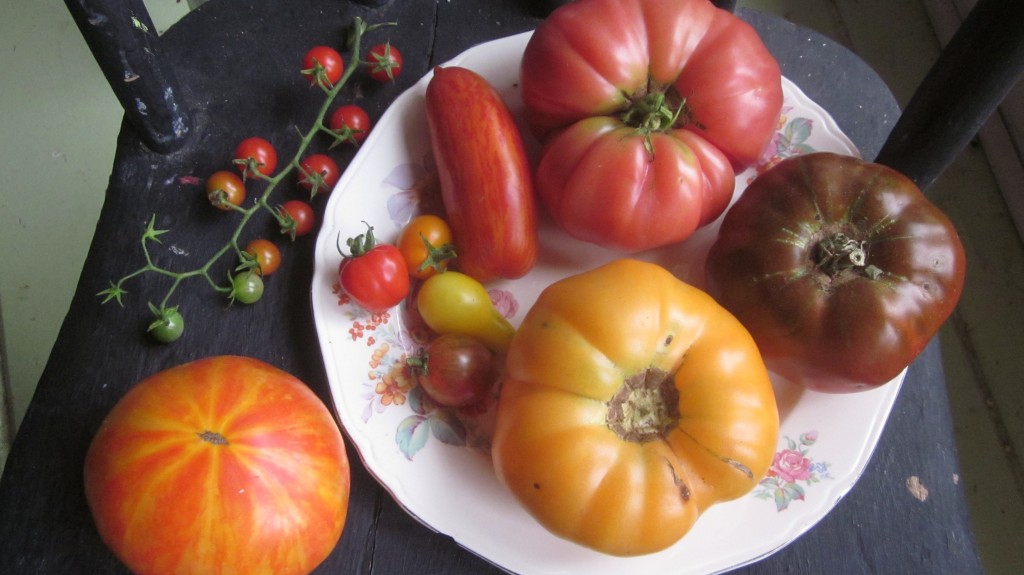
These heirloom babies grow on very large vines. They need quality support!
I have about a hundred now. Or (cough) possibly even more (whistling).
(By the way . . . I do get a bit of ribbing about how many tomato plants I plant every year, it’s true, but nobody seems to tease me about it when I pull out a jar of salsa or make some chili out of my canned heirloom tomatoes . . . . just sayin’ . . .)
I get pretty excited about growing heirloom tomatoes, and it’s hard for me to stop at just . . . er . . . a hundred or so. There are so many different colors, and tastes, and shapes and sizes and I just want to try them all! Take a look at some of the names of the varieties I’m growing this summer:
- Black Cherry
- Pineapple
- Cherokee Purple
- Pink Brandywine
- Yellow Pear
- Thimbleberry
- Sun Sugar
- Striped Roman
- Aunt Ruby’s German Green
- Chocolate Stripes . . . the names alone are making my mouth water!
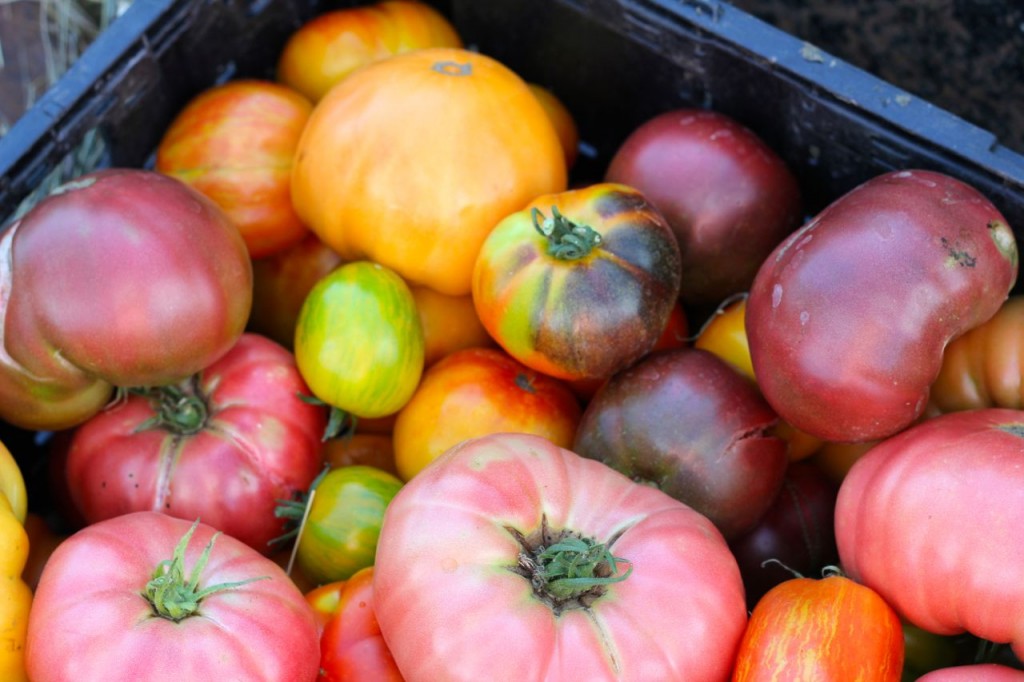
–-swoon!–
My sturdy and bright son Timothy helped me make another batch of tomato cages earlier this spring and then built the simple framework for this year’s tomato jungle. These are vigorous and productive plants, and they take some serious bolstering-up to make it through until frost in mid-October. I took pictures of the process so I could share it with you, Gentle Reader.
I’m sharing with you two important tomato-growing things here, Gentle Reader.
- One: how to make tomato cages that will last forever,
- and two: how to set them up in your garden to last all season long. (You don’t want them all blowing over during the first summer storm, of course.)
Let’s get started!
Part One: here’s what you need to make tomato cages which will last you a very long time (probably forever, I’ve had mine for 15 years now and there is no sign of deterioration):
- a roll of concrete reinforcing wire (I bought mine at Menard’s)
- some stout wire cutters
- a pair of sturdy gloves
- a strong teen-age boy, or in lieu of one:
- a few cement blocks*
- eye protection would be dandy, too!*

A nice pair of leather work gloves like these, are a must! (Click here for more info–affliate link.)
You certainly don’t have to have the teen-age boy, but he’ll thank you for something constructive to do (I’m sure!) and you can stand back and take pictures, and carry glasses of ice tea to him. And promise him a very nice lunch.
Whispers of homemade pie at job’s end, also, would not go amiss.
🙂 Word to the wise, Gentle Reader. Word to the wise.
Here’s what you do (or what you’ll instruct your teenage boy to do):
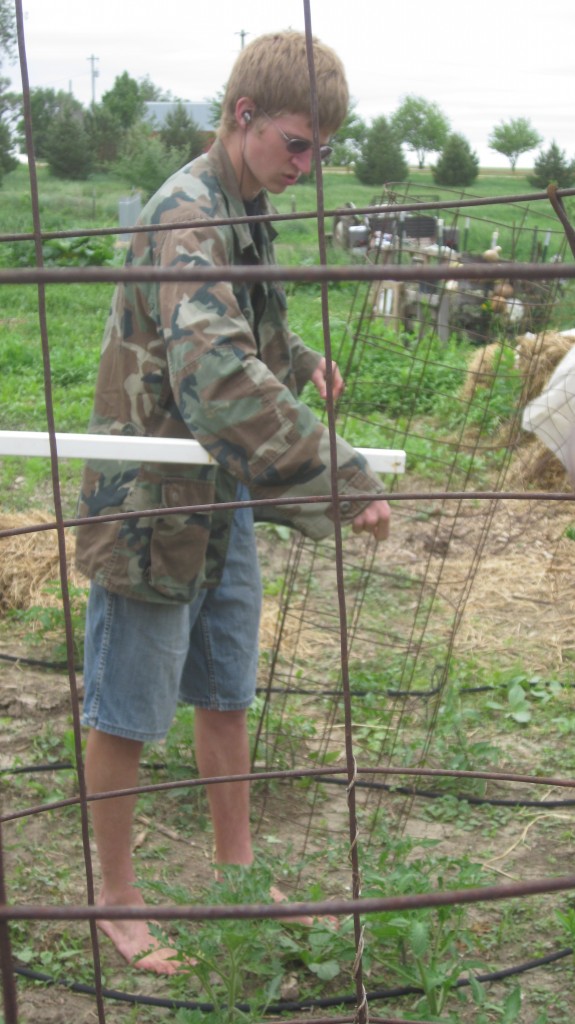
Here’s my strong teenage son, Timothy, with a tomato cage that he just made. No shoes. No eye protection. *sigh*
One tomato cage takes about a five foot length of the mesh–or 12 squares–so you simply count off that length and cut through the wire with the wire cutter.
Because the mesh has been stored in a tight roll, it is helpful to have a second person to help. You don’t want it to whip up and perforate or slice your leg, or some other body part. ( This is also why I recommend using eye protection, and wearing long sleeves!)
We don’t, after all, have time for a trip to the ER today, right? Or–-ever.
After you’ve cut through the wire, bend it to make a circle (it will do this quite naturally), and then bend the cut ends to connect the circle, all along the length, to make your cage. It sounds amazingly simple, because–it is amazingly simple.
Seriously.
However, the mesh is stout and hard to cut, and that’s where the teenage boy with the strong hands comes in so handy. If the teenage boy is prudent, he’ll also wear protective gloves and eye protection. (Note my teenage son throws caution to the winds, and will laugh if I even suggest his wearing shoes . . . )
Don’t worry, by the way, if your wire is rusty. This is normal, especially if the wire is stored outside. The rust will wash off, and it won’t hurt your plants.
Once you have your cage formed, you can cut the bottom ring off, and just stab that bottom 6 inches of the cage into the ground, or–if you live in a windy area and have had tomato cages end up in a humiliating heap in your garden in years past after a storm–you may want to stake them up. That’s what I do.
Part Two: I grow such an absurd admirable number of tomato vines, that we’ve had to devise a way to stake the cages together so they will stay put all season, no matter how heavy and burdened with tomatoes they get. The following method is the only way we’ve discovered which will keep the cages intact during a summer storm.
We’ve tried quite a few different ways to stake our cages, and this is the one we’ve stuck with for many years now: because it’s easy to do, and it works.
As the wind at our place can get overpowering at times, we’ve learned to take the staking up of these vines quite seriously.
Here’s what we do: (all credit goes to my son Timothy for figuring out this design): we drive a stout t-post at the end of the row or bed. Then as I plant each tomato seedling, I place a cage over it. Meanwhile, Timothy is busy weaving a sturdy piece of PVC (you could use a 2×2, also, though somebody gave us this PVC and it works really well for this purpose–it’s light and strong, and you can drill holes in the ends and then thread wire through them) through the cages. I try to keep ahead of him, and he tries not to hit me on the head with the PVC.
He does, after all, really want the pie that was hinted at, to happen.
Then he wires the PVC to the t-post, and when he gets to the end of the PVC, he drives in another t-post. Using the piece of PVC means that we don’t have to drive a t-post for each and every tomato cage, which is handy since we don’t own 100+ t-posts.
I weave soaker hose through and around all these plants (using dripline would be even better, of course) and Amalia helps by pulling weeds and mulching around the plants with old straw.
And occasionally pointing out that it’s probably time for a break, already. 🙂
Little Mack does his part by bringing his favorite chicken, Babes, into the garden and looking for grubs for her. He makes it look very important, hoping that I won’t ask him to help any further. Babes is an important part of our team.
I guess.
After all, when one gets tired and needs a break, one can gaze at the chicken for a few moments. It’s something.
If only I could teach the chickens how to pull weeds. *sigh*
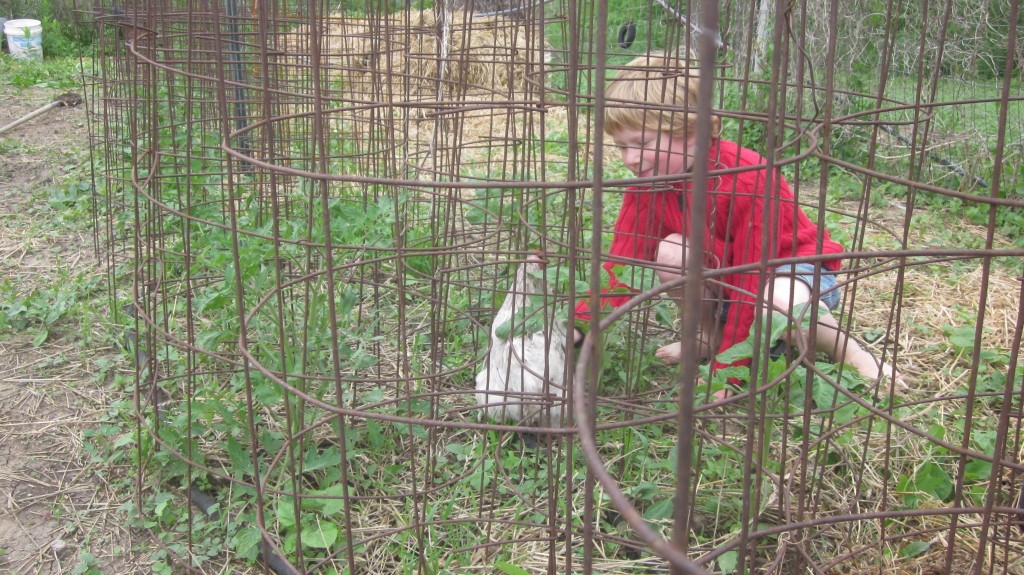
What we see as a sturdy tomato-cage fortress, Babes sees as a maze handy for eluding capture. (Malachi probably just can’t find his shoes; I did tell him to put them on.)
All those weeds in the photo will be pulled, by the way, and the ground covered with a thick (6 to 8 inches, if I can scrounge up that much mulch) blanket of mulch, which will keep the plants very happy indeed. Even if it gets very dry. Which it probably will.
Here is a line of cages, all in place. 🙂 Humble. But secure. Ready for the load of tomatoes that will come shortly.
🙂 Yay!
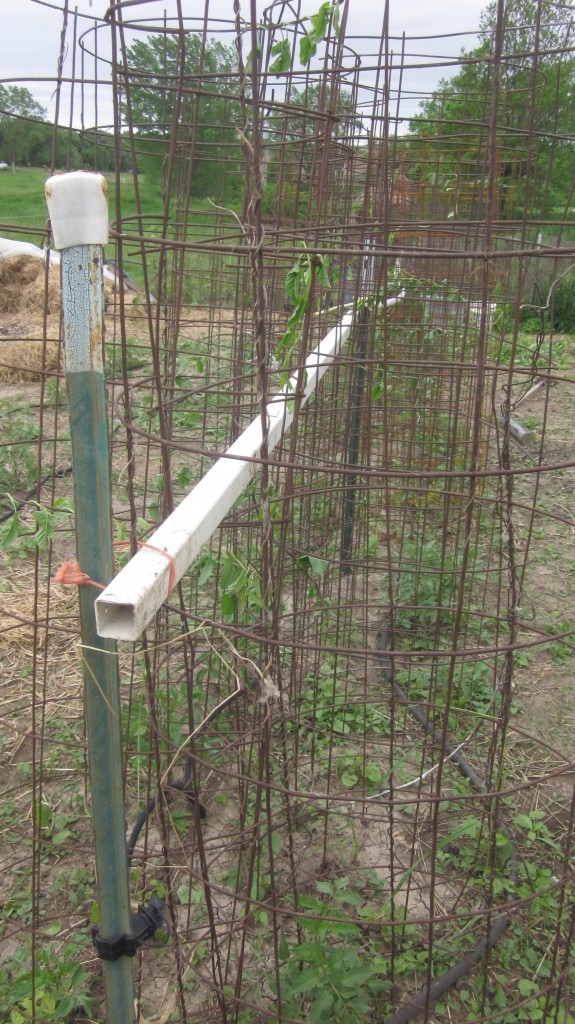
Here’s our first double row of tomato cages, supported by t-posts and PVC pipes. Timothy has used twine to attach the PVC to the t-post. Sometimes he uses baling wire, or whatever is available.
There now–was that so hard? No, not really. And just imagine it–in just a few short months, you’ll have this to look forward to:
Keeping your tomato vines off the ground will result in fewer diseases and better looking tomatoes, in my experience.
Now it’s your turn, my Gentle Reader, to make a few cages to keep your tomato vines happy!
*I want to add a safety note to this post: while my strong and determined son Timothy had no trouble making these cages by himself, usually a helper is needed. This cement mesh stuff is very stiff, and wants to stay tightly wound. You might say it resists change. A reader of mine recounted how she still bears a scar above her eyebrow, from an incident where she was helping her dad make tomato cages, and the mesh whipped up and struck her in the face, cutting her badly. She suggested that cement blocks be the best “helpers,” as they don’t have eyebrows and will hold the mesh firmly on the ground while the cage maker works with the mesh. I think this is a prudent suggestion!
I have lots more posts about growing tomatoes, so be sure to check them out! And do sign up for my email list, so you don’t miss a thing.
Thanks for reading, as always, and if you want to share this with your friends and relations, I’ll be forever grateful. 🙂 <——me, beaming with gratitude
*hugs*
- Radish Sammages: a simple-but-perfect summer lunch
- The time has come . . . for the Cornish to be OUTSIDE




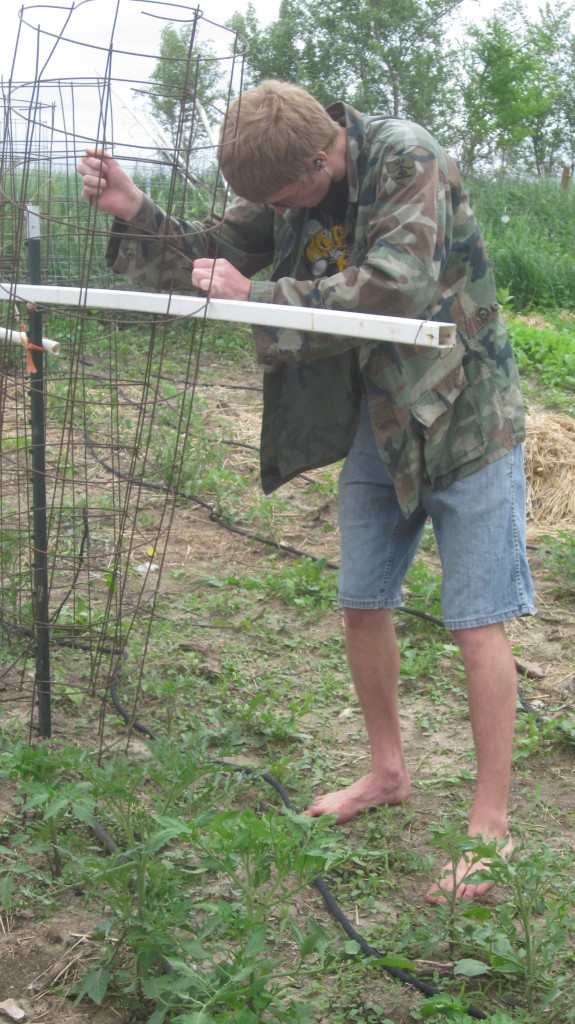
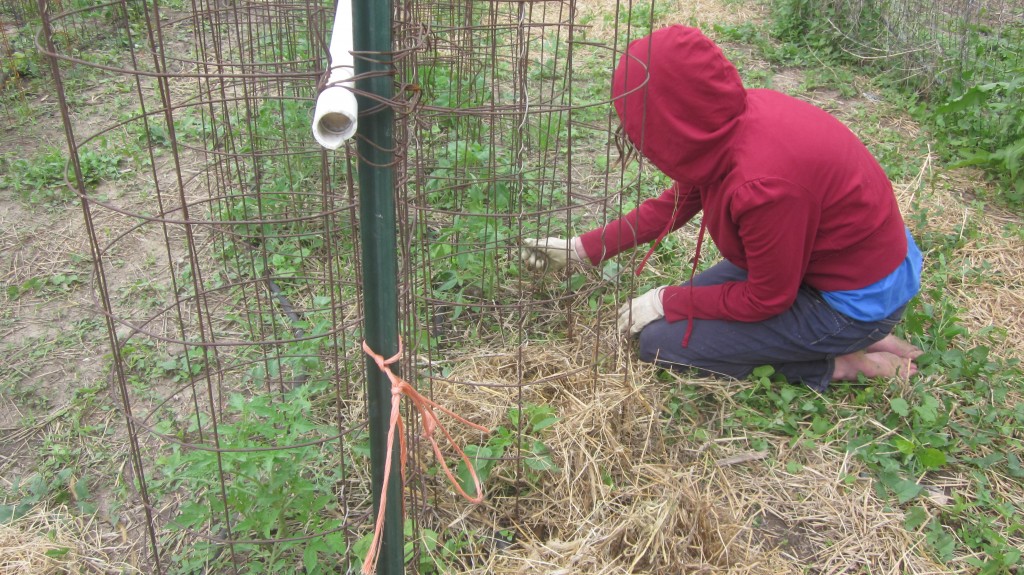
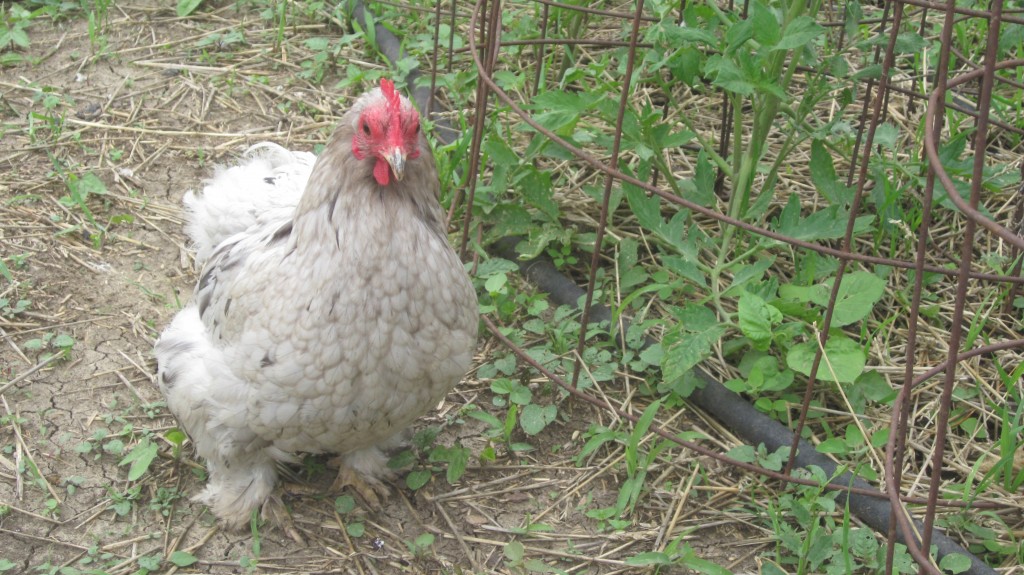
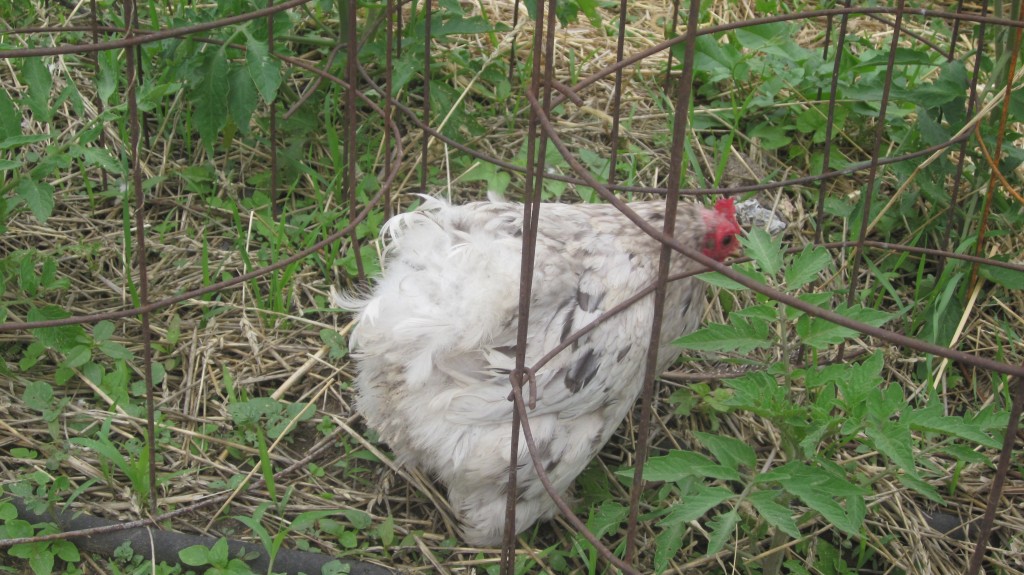
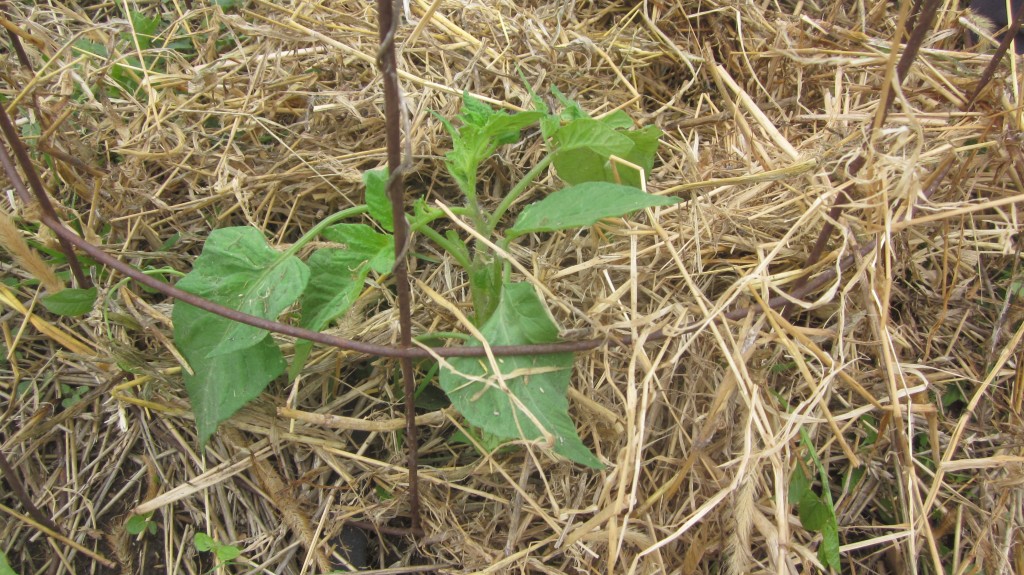
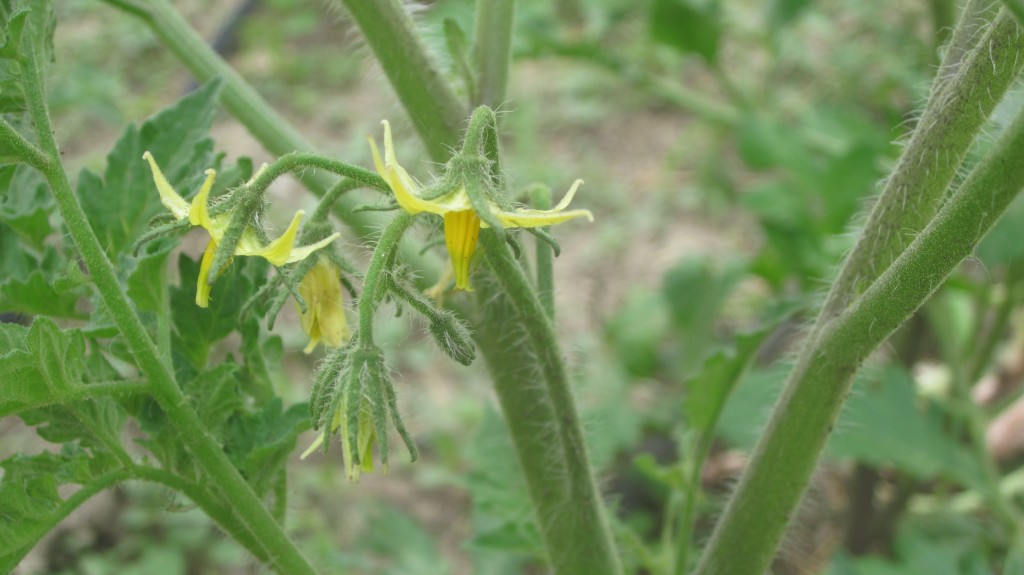
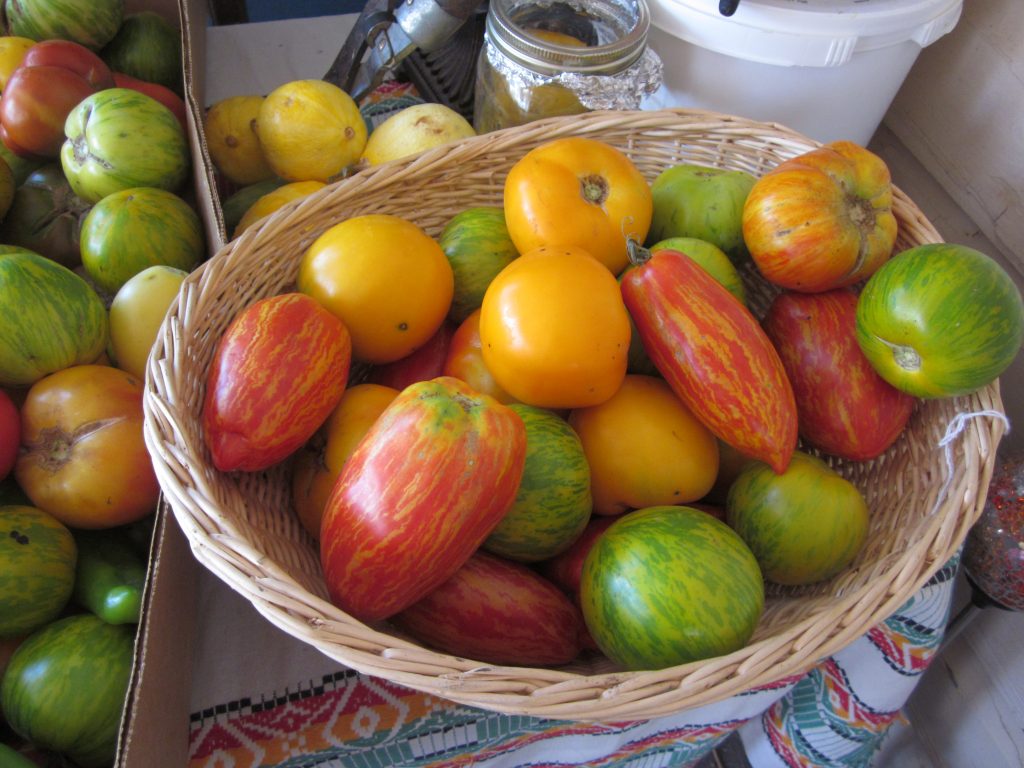
Ok, I have decided that you have way more free and willing labor than I do. If your help would like a little Southern vaKay, lemme know cus I’ll trade room and board for a little elbow grease.
Okay, I’ll thank you for the offer on Timothy’s behalf. Are you close to the ocean? I love an ocean view, and I’d be happy to tag along as . . . um . . . well, he doesn’t need a chaperone, but I could help with the driving!
I was so excited that I planted a tomato plant (like in one) that will grow to 12 feet this season. Now you tell me we’re going for the jungle effect. Well maybe next season in Mexico I will give it a shot. I am so busy packing, moving things into storage etc. That I am not getting as much outdoor time as I would like. We have about 10 tomato plants total. Plus peppers and stuff of course.
Chef,
You’ll need plenty of fresh tomatoes down there in Mexico, what will all those salsas and salads that you make! Better add some tomatillos too!
My husband (the main veggie gardener) uses the age-friendly method of stakes and pruning. We have a community garden and we can’t put up anything too industrial-strength. But I am drooling over your tomatoes and tomato plants! Are you using composted chicken manure as fertilizer?
Alana,
I do use composted chicken manure as fertilizer. Usually very early in the spring, I clean out the chicken coop and spread it right where the tomatoes will be planted. (I rotate crops.) Then my dad comes on a nice day and rototills it into the soil. I plant the tomato vines a couple of months later, and they seem to be quite happy! 🙂
WishnI had better weather to do this here! Thanks for sharing Amy!
Thank you, Michelle!
Wow, those are some impressive tomato plants! My are small and weak compared to yours, but still excellent tips for the cage.
Thanks, Anita! I think our soil just happens to be perfect for growing tomatoes.
Thanks Anita!
….so what are you and Timothy planning next? I feel sure there is some equally inventive horticultural contraption brewing!
That’s a good question, Caro. We’ve spent quite a bit of time working on the hoop house project, so probably that’s it for now. 🙂
What an amazing idea, I love the thought of a jungle of tomato plants, please send Timothy to London on the next plane, I need his expertise !
Timothy works for food, so I’m sure he’d be your slave, Anita-Clare!
So we are all booking Timothy then 🙂 Great post Amy your toms look amazing – I thought mine were large until I saw your Jungle LOL xx
Timothy is going to be spread a bit thin this month, I’m thinking, Cher! Thanks for your comment! 🙂
What a fantastic idea & they look great! I wish we had home grown vegetables, but in England, you really need a greenhouse to grow tomatoes! It’s just too cold!
Ahh, Sophie, if you ever visit the States, stop by and I’ll share our tomatoes with you!
Goodness, I was just hoping to have my tomatoes produce something! That veritable jungle is amazing!! The tomatoes look gorgeous… jealous to the max!
I’m not sure what Timothy has planned, but it looks like he could do a world tour!
Carrie, Timothy is a lad of many talents but he still condescends to help his desperate mum from time to time. I’m so BLESSED.
Emmett and I read this together (well, I read it; he stared at our window blinds). We can’t wait to come see you!
Oh–Emmett, Emmett, Emmett, come see Amma now–I can’t wait to hold you!
I was JUST talking about how I want to start a garden! Too bad I live in an apartment complex… One day, one day! 🙂
Hold on to that dream, Gigi! It’ll happen. If you have a balcony, you know that you could have a patio tomato plant in a pot! That’s what I did when I was in an apt. There are specific plants made just for pots.
I cannot wait to get home at the end of the week and try to make these. I am tired of the weak cages that fall over at the slightest storm.
Debbie, these cages will not fall over, especially if you do a great job of staking them!
I am totally impressed with your tomato forest! Like seriously impressed. Not sure what else to say even. Words escape.
I think I am a little bit jealous though. My husband and I have been working on our plan to live and travel full time in our RV, so tomato plants seem a bit out of reach. Maybe we can come park by your garden sometime on one of our trips.
Wow!
Arla,
You are totally welcome to come spend some time out here on the prairie with us! I’ll have plenty of tomatoes to share! Thanks for your nice comment. Do you ever travel through Nebraska (fly-over country)?
Cages from concrete wire mesh are definitely the way to go! Here is a short video that shows how to make them. http://www.tomatodirt.com/build-tomato-cages.html.
I’ve never seen tomato vines as big as the ones in your photo. Love the look of those striped tomatoes in the basket. I’d like to taste them.
Oh, Francene, I wish you could come over and visit me in mid-August and you could taste as many as you like!
Nor have I EVER EVER seen tomato plants so huge . . . but then I am in the UK . . . sigh! 🙁
Tomato plant envy? Well yes . . .
I can’t take all the credit, Kaye, of course. Our soil apparently is very good for tomatoes, and the weather is, too (hot and dry that summer!). The proof is in the fruit, anyway, not the plants! 😉 How do your tomatoes grow?
They grow sadly! 🙁 Greenhouse/polytunnel a necessity in this climate and those items are on my wish list!
Was hoping to send you a photo of a tomato I took when in Provence with my son’s family . . . will send this beauty by email for you.
A word of warning when dealing with the reinforcing wire that likes to spring back into a roll as you try to unroll it – I was the second person designated to hold down that springy wire while my dad cut the proper length. That is, I was until the wire slipped once and nearly poked my eye out. That was nearly ten years ago, and I still have the scar on my right eyebrow. Since that mishap, my family only uses cement blocks to weigh down the wire while cutting. Just a little safety tip! 🙂
Thanks Sonia! I appreciate this safety hint. Timothy always works alone when he makes tomato cages, but you’re right that that springy wire can be dangerous. I added a safety note to the blog post. Thanks again!
Great that you posted this again. We are “hitting for the bleachers” this summer with well over 50 tomato plants, lots of peppers, eggplant, etc. I have given my daughter and her husband the ok to remove half the 1200 sq. foot front lawn and turn it into a 4 x 4 garden. We will need cages. If all goes well it should be 100% heirloom next year and I will ok them taking over another 25 percent of the lawn. My garden in Mexico was a little week this year due to construction, but I have plans for that as well when we return in the fall. We did raise about three acres of corn but not near enough tomatoes.
WOW Chef, that’s a LOT of tomatoes. 😉 Hopefully you’ve got a nice selection of heirlooms planned?
Pingback: Tomato Plant Help For Eyebrows That Won't Grow Back
I’m in awe…I never knew tomatoes grew that big!! I’m in total shock. Those aren’t tomato plants, they’re TREES!! :)) Beautiful Amy, absolutely beautiful…that’s all I can say! My mouth is wiiide open.
Rose–technically–I think the plants that summer grew TOO BIG. They put too much energy into the plant, and not as much into the fruit. (I still got lots of tomatoes.) I think my soil was too fertile (go figure). Wait until you see how big the tomatoes in the hoop house get–I’m going to post pictures this week, Lord willing–those plants really really love the hot conditions of the hoop house. You’ve gotta get one, Rose . . . 🙂
I used to make cages just like yours, but had to leave them behind in a previous move. Thanks for reminding me of the technique. I think I’ll make them again. They really are better (and less expensive )than most commercial cages.
And Mike, they last FOREVER. Next time, just strap them to the top of the moving van. No wind resistance to speak of!
Totally awesome and tomatoes looks beautiful! Its getting to be late summer for my area, and my poor tomatoes are finally growing after many months of rain (not usual for my area in the midwest, we have had A LOT this year) but I haven’t had time to stake or cage them! They’re already falling and growing twisted 🙁 Still transplanting other items in the garden too – oops! Lack of time and rapidly-growing 20 tomato plants seduced us into buying crap cages at menards, but I like your idea for next year better! My only thought is to try doing a straighter fence instead of cages, which I was inspired by another article and probably requires more t-stakes, but can’t hurt to try? I might not have Timothy but I do have an awesome boyfriend (mechanic/electrician/welder) that is very handy and creative, who embraces my gardening adventures with enthusiasm and helps by rototilling for me. I’m thinking of ways we can use some scrap metal pipes and wire to do this for next year already…plus I’m lucky enough to have an old school (used to be blacksmith shop way back) metal fab shop nearby to make unique iron posts (little extra $ but great quality and hand made farm stuff that will last) – very excited and thank you for sharing!
Niky,
I’m so glad you found me. I love your comment, and your gardening enthusiasm is obvious. We are kindred spirits, I know it! Plus, your boyfriend sounds awesome. Please, please send me pictures when you have your tomato-support systems in place next year. I’d love to see it. I’m all about making things as easy as possible, that’s why I go with these cages year after year–I have them and they work well, so I use them!!–but that’s not to say that it’s the ONLY way to support tomato cages! I love the idea of your unique iron posts. Sounds really fun!
Do you have any tips for growing in an un heated greenhouse? I am excited to get started. Can I start tomatoes and such indoors now and then transfer to the greenhouse while waiting for our frost free date? Usually I start them indoors mid Feb….. I also hae tomato cages made the same way 🙂
Lynda, dear Lynda: I’m anxious to start, too! I grow my cold-sensitive baby plants such as tomatoes and peppers inside to begin with (most seed envelopes give you pretty good info on when to start them. . . for example “start inside 4 to 6 weeks before frost-free date) and then you might be able to transfer them into your greenhouse a week or two before the frost-free date. Ours is around May 10. The thing is, if we have a sudden cold snap (and sometimes, we do) the unheated greenhouse WILL get cold, too. If you just can’t wait—stir up some ground in there and plant some cold-hardy greens in a cold frame. My baby kale, mustard greens, and arugula that I planted in September are still doing great! But they are safely tucked into cold frames. I’ll be including pictures on my blog, today or tomorrow.
Shrinking with embarrassment….I’ve never been able to grow a tomato. I’ve tried. I want to. I want to try again…..you inspire me, as always.
Renee,
It’s not hard. Tomatoes love heat, regular watering, and some sort of support. And decent soil. That’s it!! Grab a tomato plant from your favorite nursery, plant it and see how you get spoiled to really really good tomatoes!
I enjoyed reading this page because of your humor and your barefooted children lol. What do you use to keep stink bugs off your maters?
Um, Amber—when I see them, I pinch them!!
I think I’m the first to ever build a tomato cage like this. I guess it was around 40 yrs ago when I built the ones I have now, which are in BAD shape. At least they were the first ones I ever saw. Now everybody and his brother around here has them. Gonna build a few new ones before long. I think I made mine a little bigger around than your, with 14-15 squares. I also used the cement wire for hoops to go over plants in cold weather. Of course, you had to put plastic on the hoops. Worked pretty good though. These are all decimated too.
What size squares do you look for in the concrete wire mesh?
Mike,
The squares in the wire mesh I use are about 5″ across. I think this wire was the only type available at the hardware store, though. Don’t buy the cheap flimsy stuff with the smaller squares. It’s not worth the trouble!
I inherited two tomato cages made of reinforcing wire. Iva always used the 7 ft. Fence posts and cut off water pipes which were saved when plastic replaced them. They can be pounded in with a post pounder…a real thing…on the inside or outside of the cages. Either way, snug the cage close and fasten with plastic zip strips, two to four of them. Used plastic water pipe or more lengths of metal water pipe thru the cages to hold up the frail type of cages in between those two concrete mesh ones and more tall back posts with some electric fence small posts if needed. All fastened with the plastic zip strips. Resists high winds.
This year, we’re both over 80 yrs. old and pounding in the tall posts may not be feasible. I plan to use thicker pieces of rebar of shorter length and fastened by plastic zip strips. Also plan to find someone to make more cages out of concrete mesh reinforcing wire…… previously had flimsy wire two piece cages in between the two concrete mesh cages…or in between fence posts…and it worked very well. All these steps can actually be seen in the article….thanks for allowing me to,post my experiences from home gardening for over 50 years….
Margaret, I love to learn from my gardener-readers! Thank you for taking the time to share these tips with me!
Your caves appear to be only about 5ft tall, but your plants appear much taller. How does that work?
Good question, Wendy. I am only a bit over 5′ tall myself, so even if the cages were twice as tall, I’d not be able to harvest the tomatoes much higher than I already do. This is what happens: My heirloom tomato plants just keep growing over the tops of the cages, and then they grow down to the ground eventually, which actually makes them quite easy to harvest. A kind of curtain of fruit just cascades over the sides of the cages to the ground. I tried pruning the tops one year, but they just keep growing anyway, and I basically don’t have the time to prune them over and over again. I’ll try to make an update to this post, with pictures, before my vines freeze this year. So check back !
Amy
I have to ask what in the world you are feeding those tomato plants. I’ve never seen any that big here in KY. Last year, I used those little cages from the store. And my plants held up well. But they weren’t have as tall as yours. I must be leaving something out! Would be thrilled if I could get plants that big with good size tomatoes.
Hi Joe!
One thing is that many of the indeterminate heirloom tomato plants do get BIG. If you are planting, say, determinate tomatoes (the ones that produce all at once) they won’t get as big. Neither will the tomato plants that are designed for patio growing in pots, of course. My recipe for growing great big healthy plants: I work chicken manure into the soil twice during the year–once in the fall, once in the early spring. I mulch heavily. I water often. I apply some sort of organic fertilizer probably once per month or so. And that’s about it! Some years they produce more than others, depending on the weather. I do have very good soil, too, here in Nebraska, so I can’t take all the credit! You may also want to take a soil test, if you’ve not done that in awhile. Here’s a good article on how to mix just the right soil for tomatoes, if you have raised beds, too: http://www.growgardentomatoes.com/soil-for-tomatoes.html
Firstly I have read many posts on tomato cages this one was by far the most entertaining…
A simple question from an amateur gardener. I am about to make my own tomato cages (about 24 inches in diameter) can I plant more than 1 plant per cage? The reason I ask is that i planted a ton of tomato plants that are growing too well and I need to start pulling them out as I insert my cages. I was hoping I can do more than one per cage. Its so sad to pull out these thriving plants
JJ, no, no, no, don’t do it! I know how tempting it is to plant them closely, but take it from one who has done the same thing and then lived to regret it mightly: don’t do it. Tomato plants like lots of air, nutrients, and they LIKE THEIR SPACE. Overcrowd them, and they will be more susceptible to disease and will not produce as much. In fact, I planted mine farther apart this year than ever before (I usually crowd them) and I had much stronger and more productive plants! Lesson learned! Word to the wise! Find more space for your extras, or give them to your friends–or–do what I did finally–have a little plant sale and make a little $$ for your pocket! Good luck and thank you for the kind words. I do enjoy writing an entertaining how-to post very much!
I have tomato cages similar to your but I have trouble storing them in the off season. They take up a lot of room. Any suggestions? Otherwise, I do love them.
Olivia, this year I have mine lying on their sides and stacked up in pyramidal type shapes, in a few different out-of-the-way locations on our farm, yet close to where I’m going to plant tomatoes this spring. They look orderly and neat, kind of like I know what I’m doing (ha!). And the songbirds like to take refuge in them, which I enjoy. 🙂
Thanks for the reply. I’ll try that. I have mine clustered upright in an area but here in the sf bay area the weeds tend to grow up into them in Jan, Feb, and March. Our lot is largish ( 100 x 200) but not as much space as you probably have on the farm. The birds do like them though. I had some near the bird bath and one day recently there were 15 or so perched in the cages and taking turns in the bath. It was really fun to see.
Olivia, a birdbath near my stack of tomato cages would be a brilliant placement!
These are the kind of tomato cages that I have (Thanks, Dad), and I agree that they are the best ever. In my case, I have them in a big rectangle surrounding, or fencing in, my garden. We have so many deer where I live. The deer are not interested in tomato plants (or cucumber plants which I train to grow up the cages instead of out onto the ground), so they leave them alone. The tomato-cage fence protects the plants on the plants (okra, peppers, onions, squash, etc.) that the deer do like. I leave one tomato cage empty and un-tethered to the ground to act as my gate to the inside. 🙂
Helen, I have a question for you: do you have the tomato cages lying flat on the ground, or standing up in a row, to act as your deer fence?
Mine are standing up just like yours. I have to tell you though… my garden is much much smaller than yours. I have about 30 tomato cages. I put tomato plants in about 4/5 of them and cucumbers in about 1/5 of them. I’ve set up my garden this way for several years. It works for me.
A few things learned… only plant un-appetizing (tomatoes & cucumbers) in the outer circle of cages. A deer’s nose will fit right through to eat every single leaf of an okra plant or a sunflower within 4-5 inches of the outside of the cage. 🙂
Helen, such great ideas! Thank you very much!! I have to plant strategically, against bunnies, deer, and . . . my chickens, ha!!
What a lovely read! I love your carefree-shoeless children 🙂
Thank you, Jen!
This blog post is SO helpful! I’m planning on buying concrete mesh to make tomato cages this year. It’s been a few years since you created this post so I’m hoping you can answer a few questions because maybe you have made changes since then.
1. How wide & tall do you make your cages?
2. It looks like you installed your cages so that they’re touching each other. Do you still place them this close?
Thank you so much!
Hi Claire! The concrete mesh is around 5′ wide, so that is how tall my cages are. And you can decide how wide to make them. I usually count off 10 squares and make them that wide. I still place my cages so they touch, but I now do a single row instead of a double one, so there is more air flow! (Good question!) I wire the cages together in a row, so our Nebraska wind doesn’t blow them all over, and for ease in staking them all up. Good luck!!
My husband and I made these cages about 15 years ago and they are still going strong. I love my tomatoes and how big they get and how prolific the vines are by being supported. These cages make pruning and watching for ‘problems’ much easier. Our soil is very much on the sandy side so we thread a soaker hose through the bases of each plant. Tomatoes love a constant steady feeding of water to make those big beautiful fruits. Happy Gardening to all.
Thanks for your input! I agree that they hold the plants us very nicely, and they allow for good air flow (which is so important for tomato health!). (That is, unless you pack them too tightly together as some folks *cough* used to do.)
How do you store these in the off season?
Hi Kyle! It’s very simple. I stack them in pyramids along my fence line. I stack them as high as I can reach. The song birds use them during the winter for perching and shelter!
Kyle, though I own over a hundred of them, you’d be hard-pressed to find them on our property. I stack them up in pyramids near a fence row. That’s it! The wild birds seem to like to perch in them. They are beautiful when covered with frost or glumpy snow, but they are nearly invisible otherwise.